Geocoding processes in cohort studies: methods applied in the EpiFloripa Aging
- PMID: 37971072
- PMCID: PMC10681526
- DOI: 10.11606/s1518-8787.2023057004976
Geocoding processes in cohort studies: methods applied in the EpiFloripa Aging
Abstract
Objective: To describe the process and epidemiological implications of georeferencing in EpiFloripa Aging samples (2009-2019).
Method: The EpiFloripa Aging Cohort Study sought to investigate and monitor the living and health conditions of the older adult population (≥ 60) of Florianópolis in three study waves (2009/2010, 2013/2014, 2017/2019). With an automatic geocoding tool, the residential addresses were spatialized, allowing to investigate the effect of the georeferencing sample losses regarding 19 variables, evaluated in the three waves. The influence of different neighborhood definitions (census tracts, Euclidean buffers, and buffers across the street network) was examined in the results of seven variables: area, income, residential density, mixed land use, connectivity, health unit count, and public open space count. Pearson's correlation coefficients were calculated to evaluate the differences between neighborhood definitions according to three variables: contextual income, residential density, and land use diversity.
Result: The losses imposed by geocoding (6%, n = 240) caused no statistically significant difference between the total sample and the geocoded sample. The analysis of the study variables suggests that the geocoding process may have included a higher proportion of participants with better income, education, and living conditions. The correlation coefficients showed little correspondence between measures calculated by the three neighborhood definitions (r = 0.37-0.54). The statistical difference between the variables calculated by buffers and census tracts highlights limitations in their use in the description of geospatial attributes.
Conclusion: Despite the challenges related to geocoding, such as inconsistencies in addresses, adequate correction and verification mechanisms provided a high rate of assignment of geographic coordinates, the findings suggest that adopting buffers, favored by geocoding, represents a potential for spatial epidemiological analyses by improving the representation of environmental attributes and the understanding of health outcomes.
OBJETIVO: Descrever o processo e as implicações epidemiológicas do georreferenciamento nas amostras do EpiFloripa Idoso (2009–2019).
MÉTODO: O estudo de coorte EpiFloripa Idoso buscou investigar e acompanhar as condições de vida e saúde da população idosa (≥ 60) de Florianópolis em três ondas de estudo (2009/2010, 2013/2014, 2017/2019). Com uma ferramenta de geocodificação automática, os endereços residenciais foram espacializados, permitindo a investigação do efeito das perdas amostrais do georreferenciamento em relação a 19 variáveis, avaliadas nas três ondas. A influência de diferentes definições de vizinhança (setores censitários, buffers euclidianos e buffers pela rede de ruas) foi examinada nos resultados de sete variáveis: área, renda, densidade residencial, uso misto do solo, conectividade, contagem de unidades de saúde, e contagem de espaços livres públicos. Coeficientes de correlação de Pearson foram calculados para avaliar as diferenças entre as definições de vizinhança de acordo com três variáveis: renda contextual, densidade residencial e diversidade de uso do solo.
RESULTADO: As perdas impostas pela geocodificação (6%, n = 240) não ocasionaram diferença estatística significativa entre a amostra total e a georreferenciada. A análise das variáveis do estudo sugere que o processo de geocodificação pode ter incluído uma maior proporção de participantes com melhor nível de renda, escolaridade e condições de vida. Os coeficientes de correlação evidenciaram pouca correspondência entre medidas calculadas pelas três definições de vizinhança (r = 0,37–0,54). A diferença estatística entre as variáveis calculadas por buffers e setores censitários ressalta limitações no uso destes na descrição dos atributos geoespaciais.
CONCLUSÃO: Apesar dos desafios relacionados à geocodificação, como inconsistências nos endereços, adequados mecanismos de correção e verificação propiciaram elevada taxa de atribuição de coordenadas geográficas. Os achados sugerem que a adoção de buffers, favorecida pela geocodificação, representa uma potencialidade para análises epidemiológicas espaciais ao aprimorar a representação dos atributos do ambiente e a compreensão dos desfechos de saúde.
Conflict of interest statement
Conflict of Interest: The authors declare no conflict of interest.
Figures




References
-
- Schulz AJ. In: Encyclopedia of Environmental Health. Nriagu JO, ed, editor. Elsevier; 2011. Urban environments and health; pp. 549–555. place unknown.
MeSH terms
LinkOut - more resources
Full Text Sources

